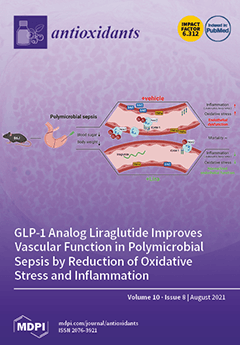Plant-derived antioxidants are a large group of natural products with the capacity to reduce radical-scavenging. Due to their potent therapeutic and preventive actions, these compounds receive a lot of attention from scientists, particularly pharmacologists. The pharmacological activities of the
Azima tetracantha Lam. (
AT) plant, belonging to the Salvadoraceae family, reported here justifies its traditional use in treating several diseases or disorders. This study aims to look at the propensity of certain plant compounds found in natural
AT plant extracts that might play a critical role as a secondary metabolite in cervical cancer treatment. There is a shortage of information on the plant’s phytochemical and biological characteristics. Methanol (MeOH) solvent extracts of the dried
AT plant were screened phytochemically. Its aqueous extract was tested for antioxidant, antiseptic, anti-inflammatory, and anticancerous properties. Absorption Distribution Metabolism and Excretion (ADME/T), Docking, and HPLC were also performed. In clinical treatment, the plant shown no adverse effects. The antioxidant activity was evaluated and showed the highest concentration at 150 µg/mL (63.50%). MeOH leaf extract of
AT exhibited the highest and best inhibitory activity against
Staphylococcus aureus (15.3 mm/1000) and displayed a high antiseptic potential. At a 200 µg/mL concentration, MeOH leaves-extract inhibited red blood cells (RBC) hemolysis by 66.56 ± 0.40, compared with 62.33 ± 0.40 from the standard. Albumin’s ability to suppress protein denaturation ranged from 16.75 ± 0.65 to 62.35 ± 0.20 inhibitions in this test, providing even more support for its favorable anti-inflammatory properties. The ADME/T studies were considered for a potential cancer drug molecule, and one of our compounds from MeOH extract fills the ADME and toxicity parameters. The forms of compound 4 showed a strong hydrogen-bonding interaction with the vital amino acids (ASN923, THR410, LEU840TRY927, PHE921, and GLY922). A total of 90% of cell inhibition was observed when HeLa cell lines were treated with 300 µg/mL of compound 4 (7-acetyl-3a
1-methyl- 4,14-dioxo-1,2,3a,3a
1,4,5,5a,6,8a,9b,10,11,11a-tetradecahydro-2,5a epoxy5,6a (methanooxymethano)phenaleno[1′,9′:5,6,7]indeno[1,7a-
b]oxiren-2-yl acetate). The polyphenol compounds demonstrated significant advances in anticancer drug properties, and it could lead to activation of cancer cell apoptosis.
Full article






